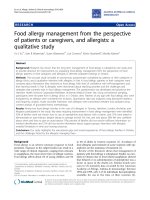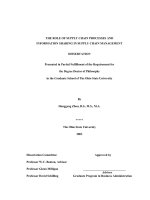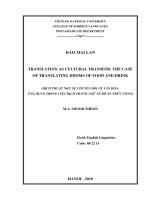report cross cultural management the challenge of multicultural work groups and teams
Bạn đang xem bản rút gọn của tài liệu. Xem và tải ngay bản đầy đủ của tài liệu tại đây (1.43 MB, 17 trang )
<span class="text_page_counter">Trang 1</span><div class="page_container" data-page="1">
TON DUC THANG UNIVERSITY
<b>FACULTY OF BUSINESS ADMINISTRATIONDIVISION OF DEPARTMENT OF ECONOMICS</b>
<b>Academic year: 2023 -2024Lecturer: Tran Thi Van TrangSubmission Date: December 2023</b>
<b>FOR EXAMINERS ONLY</b>
Grade (in number):………
Grade (in words)……… Examiner 1 (Signature & Full name)
……… Examiner 2 (Signature & Full name)
<b>HO CHI MINH CITY, 2023</b>
TON DUC THANG UNIVERSITY
</div><span class="text_page_counter">Trang 2</span><div class="page_container" data-page="2"><b>FACULTY OF BUSINESS ADMINISTRATIONDIVISION OF DEPARTMENT OF ECONOMICS</b>
<b>CROSS-CULTURAL MANAGEMENT</b>
The Challenge of Multicultural WorkGroups and Teams
1 Nguyễn Duy Khoa 720K09392 Nguyễn Vương Cơng Khơi 720K09403 Nguyễn Đình Vũ 720K0648
<b>HO CHI MINH CITY, 2023</b>
<b>TABLE OF CONTENT</b>
</div><span class="text_page_counter">Trang 3</span><div class="page_container" data-page="3"><i><b>1.WORK GROUP...7</b></i>
<i><b>2.WORK GROUP EFFECTIVENESS...7</b></i>
<small>2.1External or Contextual Conditions...8</small>
<small>2.2Resources of Group Members...8</small>
<small>2.3Structure of the Group...8</small>
<small>2.4Group Task...8</small>
<small>2.5Group Process...8</small>
<small>2.6Composition of the Group...8</small>
<i><b>3.CULTURE’S INFLUNCE ON WORK GROUP...9</b></i>
<small>3.1Cultural Norms...9</small>
<small>3.2Cultural Diversity...9</small>
<small>3.3Relative Cultural Distance...10</small>
<i><b>4.GLOBAL VIRTUAL TEAMS...10</b></i>
<i><b>6.MANAGING MULTICULTURAL WORK GROUPS...14</b></i>
<small>6.1Work Group Task and Structure...14</small>
<small>6.2Broad Evaluation Criteria...15</small>
<small>6.3Composition and Task Requirements...15</small>
<small>6.4Common Purpose...15</small>
<i><b>CONCLUSION...17</b></i>
</div><span class="text_page_counter">Trang 4</span><div class="page_container" data-page="4">First and foremost, we would like to express our sincere gratitude to our advisor, Lecturer Ms. Tran Thi Van Trang, for her invaluable guidance, feedback, and support throughout the process of researching and writing this report. Their extensive expertise in the field of organizational behavior greatly informed our analysis of the dynamics of diverse work groups.
We would also like to thank our classmates Mr. Dong Quan and Mr. Cong Khoi for their collaboration during group discussions and activities which provided meaningful perspectives on the topic.
In addition, we deeply appreciate the various scholars and academics whose quality research we extensively referenced and built upon in reviewing models of work group effectiveness and formulating recommendations for optimization. This report would not have been possible without the foundational contributions of thought leaders in this domain.
high-Finally, we are grateful to the department faculty and administration for providing us with the resources, environment, and network to thoroughly examine this multifaceted area of study. The opportunity to produce this synthesized report has expanded our cross-cultural competence that we are certain will serve us well in ourfuture career.
</div><span class="text_page_counter">Trang 5</span><div class="page_container" data-page="5">Cultural diversity in work groups is becoming increasingly common in today's globalized world. As organizations expand their operations internationally, they are relying more on multicultural teams and work groups to drive innovation and achieve strategic objectives. However, cultural differences can pose unique challenges for collaboration, communication, and overall group effectiveness if not managed properly.
This report provides an in-depth analysis of the dynamics of culturally diverse workgroups and strategies for optimizing their performance. It begins by defining work groups and discussing models of group effectiveness, highlighting six key sets of variables that influence group processes and outcomes. The report then examines how cultural norms, diversity, and distance shape group interactions and productivity.
Additionally, the report explores the functioning and management of global virtual teams that rely heavily on information technology while confronting issues like relationship building, conflict resolution, and task coordination across cultural and geographic boundaries. It also analyzes how specific aspects of an organization's context such as management support, training, and rewards impact multicultural group effectiveness.
Finally, the report proposes best practices for managing diverse groups in areas like communication, structure, evaluation methods, composition, and reinforcement of common purpose and values. With culturally sensitive goal-setting, flexibility in working styles, inclusive performance metrics, and team-building initiatives, organizations can fully leverage the innovative potential of multicultural work groups.
In summary, this report provides a comprehensive review of current research on the opportunities and challenges presented by cultural diversity in work groups along with actionable strategies for optimizing diverse group processes and outcomes within a complex organizational reality. The insights can help guide decisions regarding group composition, task design, leadership approaches, training programs, and more to improve collaboration, innovation, and productivity.
</div><span class="text_page_counter">Trang 6</span><div class="page_container" data-page="6">1. WORK GROUP
A work group typically refers to a collection of individuals who come together toaccomplish a shared task or goal within an organization or project. Members of awork group usually collaborate and coordinate their efforts to achieve specificobjectives. The key characteristics of a work group include: Common Purpose,Interdependence, Interaction, Structure, Mutual Accountability, Limited Duration.Common Identity Work groups are common in various organizational settings, andthey play a crucial role in achieving specific objectives efficiently throughcollaboration and joint effort. It's important to note that the term "work group" issometimes used interchangeably with other terms such as "team" or "task force,"but the nuances of their definitions may vary depending on context.
2. WORK GROUP EFFECTIVENESS
The effectiveness of a work group depends on how well the group uses its resourcesto accomplish its task. However, not all organizational tasks have clear bestanswers. The long-term effectiveness of a work group might not be assessedaccurately by considering only how it is performing at a single point in time. So thata broader definition of work group effectiveness is needed to portray whether awork group is functioning well. First, the output of the group must meet thequantity, quality, and timeliness standards of the organization. Second, theprocesses employed by the group should enhance the ability of the group membersto work together. Finally, the group experience should contribute to the growth andpersonal well-being of the group members.To understand the implications of culture for group effectiveness, it is firstnecessary to identify the underlying dynamics of work groups. Group dynamics arecomplex, and research has produced a number of group process models. The modelidentifies six sets of variables that influence the process and performance of workgroups.
</div><span class="text_page_counter">Trang 7</span><div class="page_container" data-page="7">2.1 External or Contextual Conditions
These factors encompass the external.environment in which the group operates. Itincludes the organization's culture, the industry norms, societal influences,economic conditions, and any other external factors that impact the group'sfunctioning.
2.2 Resources of Group Members
The skills, expertise, knowledge, and capabilities of individual group members playa significant role in determining the group's effectiveness. Diversity in skills andexperiences can contribute to a more robust resource pool for problem-solving andinnovation.
2.3 Structure of the Group
The way the group is organized and structured affects how members interact andcollaborate. This involves aspects like the leadership style, communicationchannels, decision-making processes, and roles within the group.
2.4 Group Task
The nature and complexity of the task assigned to the group greatly influence itsdynamics. Clear and well-defined goals, as well as a shared understanding of thetask, are crucial for the group to work cohesively toward achieving objectives.
2.5 Group Process
This set of variables focuses on how the group interacts, communicates, resolvesconflicts, and makes decisions. The dynamics of relationships, cohesion among
</div><span class="text_page_counter">Trang 8</span><div class="page_container" data-page="8">members, norms, and the group's ability to manage conflicts and achieve consensusfall under this category.
2.6 Composition of the Group
The mix of individuals in terms of demographics, skills, personalities, and rolesshapes the group's dynamics. A balanced and diverse composition can enhancecreativity and problem-solving, while a lack of diversity might lead to groupthink orlimited perspectives.
This model highlights the interplay and interdependence of these six sets ofvariables, emphasizing that successful group performance is contingent on acombination of these factors. Moreover, it underscores the complexity of groupdynamics and the need for a holistic approach in analyzing and enhancing groupeffectiveness. By understanding and optimizing these variables, organizations canbetter support and empower their work groups to achieve optimal performance.
3. CULTURE’S INFLUNCE ON WORK GROUP
The general model of work group functioning described in this chapter makes itpossible to examine the way in which culture influences work group processes andoutcomes. While this influence is perhaps most apparent in the cultural compositionof the work group, the organizational context in which the group functions, thework group structure, and the task in which the group is involved also influencehow much cultural differences affect the work group. The cultural backgrounds of awork group’s members affect the way they function through three general types ofmechanisms:
Cultural norms: the orientations of the specific cultures represented in thegroup toward the functioning of groups
Cultural diversity: the number of different cultures represented in the group Relative cultural distance: the extent to which group members are culturallydifferent from each other
3.1 Cultural Norms
Cultural norms refer to the shared values, beliefs, and behaviors within a group orsociety. When individuals from diverse cultural backgrounds come together in workgroups, their respective cultural norms influence how they perceive and approachtasks, communicate, make decisions, and handle conflicts.
Impact on Group Dynamics: Cultural norms shape group dynamics by influencingcommunication styles, decision-making processes, and conflict resolution methods.For example, in some cultures, direct communication is encouraged, while in others,
</div><span class="text_page_counter">Trang 9</span><div class="page_container" data-page="9">indirect communication may be preferred. These differences can affect how wellgroup members understand each other and collaborate effectively.
3.2 Cultural Diversity
Variety of Perspectives and Approaches: Cultural diversity in work groups bringstogether individuals with different cultural backgrounds, experiences, andviewpoints. This diversity can be a significant asset as it introduces a wide range ofperspectives, problem-solving approaches, and innovative ideas.
Challenges and Benefits: While cultural diversity offers numerous benefits, it canalso pose challenges such as language barriers, misunderstandings due to differingcommunication styles, and potential conflicts arising from contrasting culturalnorms. However, effectively managed, diverse groups can outperformhomogeneous groups due to their richness in perspectives and creativity.
3.3 Relative Cultural Distance
Degree of Difference Between Cultures: Cultural distance refers to the extent ofdissimilarity between two or more cultures. When work groups compriseindividuals from cultures with significant differences, there might be a highercultural distance. This distance can affect the ease of communication,understanding, and collaboration among group members.
Impact on Collaboration and Performance: Greater cultural distance might lead tomisunderstandings, misinterpretations, and difficulties in finding common ground.Bridging this distance requires efforts to foster understanding, respect, and open-mindedness among group members, which, when achieved, can enhancecollaboration and overall group performance.
4. GLOBAL VIRTUAL TEAMS
Global Virtual Teams constitute work teams comprising members from diversecultural backgrounds and geographical locations, employing information andcommunication technologies for seamless communication and collaboration. Theseteams confront four primary challenges, namely communication, coordination, trust,and conflict resolution. Furthermore, the authors proffer strategic interventionsaimed at ameliorating these challenges, thereby enhancing the overall performanceand outcomes of Global Virtual Teams.
4.1 Communication
Effective communication within Global Virtual Teams is inherently challenging dueto the need to navigate linguistic, cultural, and technological impediments, all ofwhich can significantly impact both the quality and quantity of information
</div><span class="text_page_counter">Trang 10</span><div class="page_container" data-page="10">exchanged among team members. Instances of disparate language proficiency,divergent modes of message expression and interpretation, as well as varying accessto and preferences for information and communication technologies contribute topotential misunderstandings, confusion, and overall communication breakdowns,thereby diminishing team effectiveness and efficiency. To mitigate these challenges,several strategies prove instrumental:
Utilizing a universally comprehensible common language while providingexplicit instructions, expectations, and feedback.
Steering clear of jargon, slang, idioms, or humor that might not beuniversally understood or appreciated, and instead employingstraightforward language, examples, and clarifications.
Leveraging a diverse array of communication channels and media, includingemail, phone, video, chat, and social media, tailored to distinct purposes,frequencies, and intensities, and adaptable to varied situations, preferences,and needs.
Consistently offering timely feedback, acknowledgment, and appreciation toteam members, coupled with the assurance of mutual understanding throughactive inquiry, summarization, or paraphrasing.
4.2 Relationship Building and Conflict Management
Establishing and maintaining trust emerges as a pivotal challenge for Global VirtualTeams, necessitating the cultivation of confidence, reliability, and goodwill amongteam members who encounter limited or absent face-to-face interactions. Theinherent diversity in cultural values, expectations, and behaviors among teammembers may lead to disparate levels of trustworthiness, dependability, andreciprocity, thereby impacting the willingness and capacity of team members tocollaborate, share, and support one another. These divergences can precipitatedistrust, suspicion, or resentment, ultimately diminishing team commitment andsatisfaction.
Employing a discerning criterion in the selection of team memberscharacterized by elevated cultural intelligence, a proclivity for diversityorientation, and a proficiency in virtual competence, coupled with ademonstrated willingness and capacity to effectively operate within amulticultural and virtual milieu.
Implementing a comprehensive program of training and orientation designedto acquaint team members with the overarching purpose of the team, specifictasks at hand, contextual parameters, fellow members, and the requisiteinformation and communication technologies and tools integral to the team'soperational framework.
</div>








